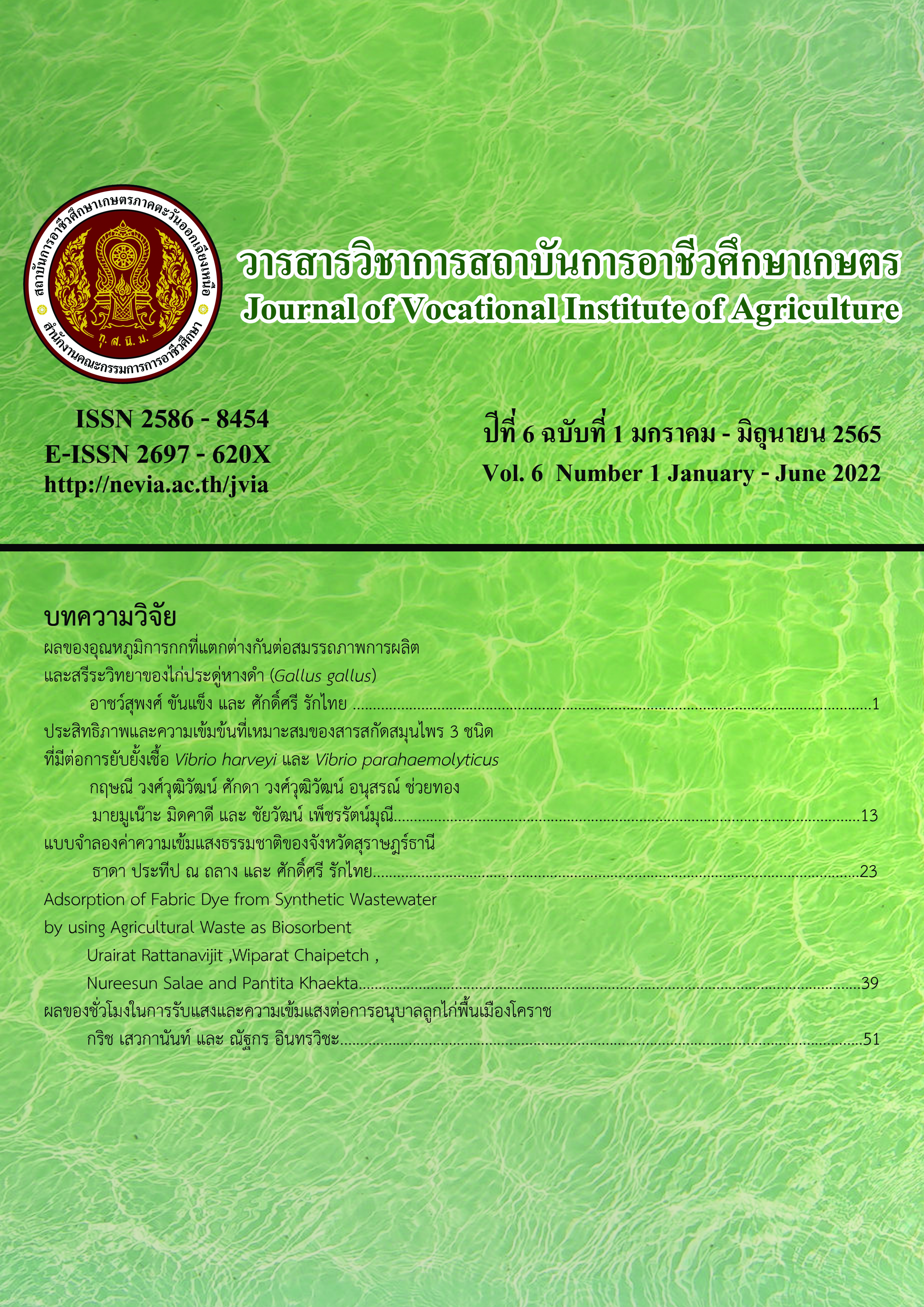ผลของชั่วโมงในการรับแสงและความเข้มแสงต่อการอนุบาลลูกไก่พื้นเมืองโคราช
Main Article Content
บทคัดย่อ
การวิจัยครั้งนี้มีวัตถุประสงค์เพื่อศึกษาชั่วโมงรับแสงและความเข้มแสงที่มีผลต่อการอนุบาลลูกไก่พื้นเมืองโคราช โดยวางแผนการทดลองแบบ 3x3 Factorial in completely randomized design ;CRD มีชั่วโมงการรับแสง 3 ระดับ ประกอบด้วย 8 ชั่วโมง 10 ชั่วโมง และ 12 ชั่วโมง และความเข้มแสง 3 ระดับ ประกอบด้วย 11-20 ลักซ์21-30 ลักซ์ และ 31-40 ลักซ์ตามลําดับ โดยทำการประเมินอัตราการเจริญเติบโต (Average Daily Gain; ADG) อัตราการแลกเนื้อ (Feed Conversion Ratio; FCR) ปริมาณอาหารที่กิน ความยาวลําตัว ความยาวปีก ความยาวรอบอก ความยาวแข้งและความยาวรอบแข้ง ผลการศึกษาพบว่าอิทธิพลร่วมระหว่างชั่วโมงรับแสงและความเข้มแสงต่อการเจริญเติบโตไม่มีความแตกต่างอย่างมีนัยสําคัญทางสถิติ (p>0.05) โดยพบว่าชั่วโมงในการรับแสง 8-10ชั่วโมงและความเข้ม11-20 ลักซ์มีความเหมาะสมกับการอนุบาลไก่พื้นเมืองโคราชที่ดีที่สุดแต่จากข้อมูลความเข้มแสงต่อความยาวตัวพบว่าความเข้มแสง 11-20 และ 21-30 ส่งผลทำให้ความยาวตัวมีค่ามากที่สุดดังนั้นน่าจะสามารถใช้ความเข้มแสงได้ทั้งสองระดับ
Article Details

อนุญาตภายใต้เงื่อนไข Creative Commons Attribution-NonCommercial-NoDerivatives 4.0 International License.
เนื้อหาและข้อมูลในบทความที่ลงตีพิมพ์ใน Journal of Vocational Education in Agriculture ถือเป็นข้อคิดเห็นและความรับผิดชอบของผู้เขียนบทความโดยตรง ซึ่งกองบรรณาธิการวารสารไม่จำเป็นต้องเห็นด้วยหรือร่วมรับผิดชอบใดๆ
บทความ ข้อมูล เนื้อหา ฯลฯ ที่ได้รับการตีพิมพ์ใน Journal of Vocational Education in Agriculture ถือเป็นลิขสิทธิ์ของJournal of Vocational Education in Agriculture หากบุคคลหรือหน่วยงานใดต้องการนำทั้งหมดหรือส่วนหนึ่งส่วนใดไปเผยแพร่ต่อหรือเพื่อกระทำการใดๆ จะต้องได้รับอนุญาตเป็นลายลักษณ์อักษรจาก Journal of Vocational Education in Agriculture ก่อนเท่านั้น
เอกสารอ้างอิง
ปราโมทย์ ธนสวัสดิ์. (2553). คู่มือไก่พื้นเมือง. พิมพ์ครั้งที่ 2. กรุงเทพฯ: ธนธัชการพิมพ์
ยุพาพร ไชยสีหา. (2554). ผลของช่วงแสงต่อระบบการสืบพันธุ์และวงจรการสืบพันธุ์ในไก่พื้นเมืองเพศเมีย: บทบาทของฮอร์โมนสเตียรอยด์ (รายงานผลการวิจัย). นครราชสีมา: มหาวิทยาลัยเทคโนโลยี สุรนารี.
เกรียงไกร โชประการ และคณะ. (2528).การศึกษาเบื้องต้นเกี่ยวกับอัตราการเจริญเติบโตของไก่พื้นเมือง และลูกผสมระหว่างไก่พื้นเมืองกับโร๊ดไอร์แลนด์เรด. ใน การประชุมทางวิชาการมหาวิทยาลัย เกษตรศาสตร์ ครั้งที่ 23 (น.3). กรุงเทพฯ: มหาวิทยาลัยเกษตรศาสตร์.
Wilson, H. R. (1991). Interrelationship of egg size, chick size, posthatching growth and hatchability. World’s Poultry Science Journal, 47(1), 5-20.
Shafey, T. M. (2004). Effect of lighted incubation on embryonic growthand hatchability performance of two strains of layerbreeder eggs. British Poultry Science, 45(2), 223-229.
Deeming, D. C. (2000). What is chick quality ?. World Poultry Science Journal, 11, 34-35.
Decuypere, E., et al. (2001). The day-old chick: a crucial hinge between breeders and broilers. World Poultry Science Journal, 57, 135-138.
Preez, J.H. (2007). The effect of different incubation temperatures on chick quality. (Master of philosophy thesis, University of Stellenbosch).
Tona, K., et al. (2005). Interrelationships between chick quality parameters and the effect of individual parameters on broiler relative growth to 7 days of age. Archiv für Geflügelkunde, 69(2), 67-72.
Fanatico, A. (2007). Poultry house management for alternative production. From https://ucanr.edu/sites/placernevadasmallfarms/files/102338.pdf.
Cohen, Y., et al. (2008). light intensity modulates corneal power and refraction in the chick eye exposed to continuous light. Vision Research, 48(21), 2329- 2325.
สุชน ตั้งทวีวิพัฒน์. (2542). การจัดการผลิตสัตว์ปีก. เชียงใหม่: ภาควิชาสัตวศาสตร์ คณะเกษตรศาสตร์ มหาวิทยาลัยเชียงใหม่.
ประชัน ฝายแก้ว. (2562). ผลของอุณหภูมิ ความเข้มแสงและความเร็วลมต่ออัตราการเปลี่ยนอาหารในไก่เนื้อเพศเมีย. แก่นเกษตร, 47(ฉบับพิเศษ 1), 775-780.
รัตนา โชติสังกาศ และพิเนต ศานติพงศ์. (2537). ผลของวิธีการให้แสงต่อการเจริญเติบโตและความสามารถทางการให้ไข่ของไก่พื้นเมือง. วารสารวิทยาสารเกษตรศาสตร์ สาขาวิทยาศาสตร์, 28(3), 390-401.
อชิรา ผดุงฤกษ์ และคณะ. (2564). ผลของระดับความเข้มแสงต่อปริมาณการให้ไข่และน้ำหนักไข่ ของไก่ไข่พันธุ์ Hisex brown และ Lohmann brown. แก่นเกษตร, 49(ฉบับพิเศษ 2), 693-697.
ประภากร ธาราฉาย. (2560). เอกสารประกอบการสอนวิชาการผลิตสัตว์ปีก. เชียงใหม่: คณะสัตวศาสตร์ และเทคโนโลยี มหาวิทยาลัยแม่โจ้.

